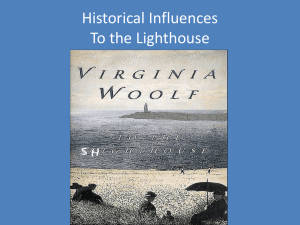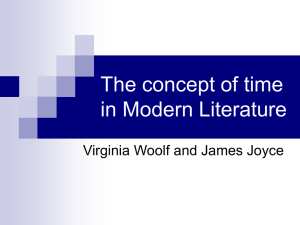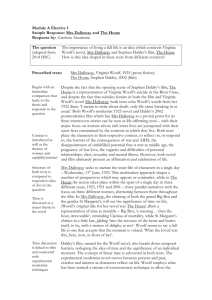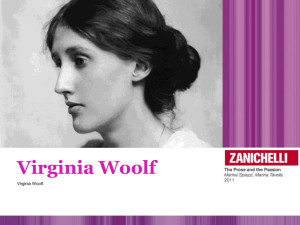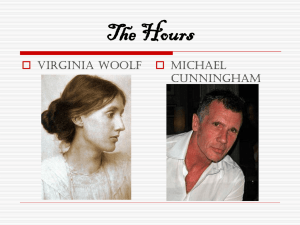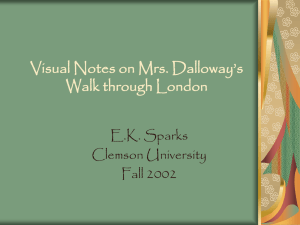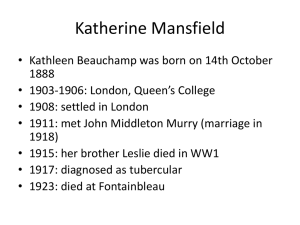VIRGINIA WOOLF
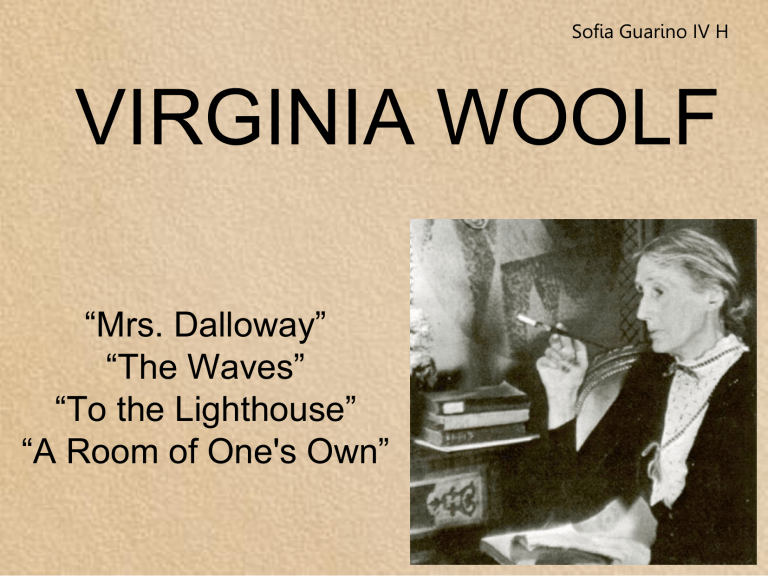
Sofia Guarino IV H
VIRGINIA WOOLF
“Mrs. Dalloway”
“The Waves”
“To the Lighthouse”
“A Room of One's Own”
Introduction
It is difficult, actually, to talk about Woolf's works in general. Each work, in fact, is worth to be analized separately from the others because each book has different characteristics and a different structure; some books even have not.
“Mrs Dalloway”, for instance, hasn't chapters or interludes which interrupt the narration periodically as in “The Waves”. “To the Lighthouse”, instead, is structured: we have three parts divided themselves in chapters. All the
Woolf's works are, however, experiments. She tries and she manages to explore the identity and the mind of her characters following the new necessities of the XX century literature, which is focused on thoughts. She chooses the writing tecnique of the monologue.This is an extract from “Mrs
Dalloway” in which we read about Peter Walsh who is thinking about a note
Clarissa has left for him:
“He wishes she hadn't written it. Coming on top of his thoughts, it was like a nudge in the ribs. Why couldn't she let him be? After all, she had married
Dalloway and lived with him in perfect happiness all these years. These hotels are not consoling places. Far from it. Any number of people had hung up their hats on those pegs. Even the flies, if you thought of it, had settled on other people's noses.”
“Mrs Dalloway”
Mrs Dalloway is certanly one of the most popular V.Woolf's works. Her ambition with the novel was to
“give life&death, sanity&insanity; I want to criticise the social system, and to show how it works at its most intense” (The Diary of Virgina Woolf, Volume 2)
In the story, Clarissa Dalloway occupies center-stage. The novel appears as a seamless account of one June day in London in 1923.
The writer definied her method as “tunnelling process” which consists in:
“I dig out beautiful caves behind my characters; I think that gives exactly what I want; humanity, humor, depth. The idea is that the caves shall connect&each comes to daylight at the present moment..” (The Diary of Virgina Woolf,Volume2)
Clarissa has, in fact, a complex personality, governed by an interior fight between two different kinds of love: the one she feels for Peter Walsh, the boy beloved in the childhood, and the one for Sally Seton,
“Sally stopped; picked a flower; kissed her on the lips. The whole world might have turned upside down! The others disappeared; there was alone with Sally.
”
Simultaneously with the thoughts and actions of Clarissa we have the presence of
Septimus, a shell-shocked young war veteran, who has seen his friend Evans diyng during the war.
In her introduction to the novel V. Woolf writes:
“Septimus...is intended to be her double.”
The cleverness of the writer can be considerably found in her shifting from a strand to another but also through time: past/present in the frequent memories of Clarissa.
A valid example of the matter is expressed in the first pages of the novel where it's stated about Clarissa buying flowers for the party and then the attention is caught by the figure of Septimus, introduced for the first time.
When the announce of his suicide arrives at the party, Clarissa has a peculiar reaction:
“Always her body went through it, when she was told, first, suddenly, of an accident; her dress flamed, her body burnt. He had thrown himself form a window. Up had flashed the ground; though him, blundering, bruising, went the rusty spikes, There he lay with a thud, thud, thud in his brain, and then a suffocation of blackness. So she saw it.”
“She felt somehow very like him – the young man who had killed himself. She felt glad that he had done it; thrown it away while they went on living.”
“The Waves”
It is considered Woolf's most difficult, high modernist text. Even though the novel has no chapters, the story is divided by nine pastoral interludes that describe the progress of the sun during the day. Between them the novel takes place with all the characters' soliloquies. There are six dramatis personae: Jinny, Susan, Rhoda, Neville, Louis, Bernard. The intention of the writer was, in fact, to compose
“ a new kind of play...proseyet poetry; a nove & a play.” (The Diary of Virginia
Woolf, Volume 3)
As Virginia writes in the “The Letters of Virginia Woolf, Volume6” about her composition of the novel:
“the six characters were supposed to be one. I'm getting old myself...and I come to feel more and more how difficult it is to collect oneself into one
Virginia”
And, in the same way, in his final monolgue Bernard makes the reader clear the idea of the sixes as one united identity:
“here on my brow is the blow I got when Percival fell. Here on the nape of my neck is the kiss Jinny gave Louis. My eyes fill with Susan's tears. I see far away, quivering like a gold thread, the pillar Rhoda saw and feel the rush of the wind of her flight when she leapt.”
But at the same time Bernard knows they're are unique persons:
“But we were all different. The wax – the virginal wax that coasts the spine melted in different patches for each of us. The growl of the boot-boy making love to the tweeny among the gooseberry bushes; the clothes blown out hard on the line; the dead man in the gutter; the apple tree, stark in the moonlight; the rat swarming with maggots; the lustre dripping blue – our white wax streaked and stained by each of these differently.”
The first section of the soliloques describes the common and segregated education for the three males and the three females. Jinny stresses the accent on the gender division in education, a theme Virginia Woolf was particularly interested in:
“...Soon Miss Carry will blow her whistle. We shall walk. We shall part. You will go to school. You will have masters wearing crosses with white ties. I shall have a mistress in a school on the East Coast who sits under a portrait of
Queen Alexandra. That is where I am going, and Susan and Rhoda.”
As always in Virginia Woolf's works the interiority of the characters has a vital place in the novel:
“The woods had vanished; the earth was a waste of shadow. No sound broke the silence of the wintry landscape. No cock crowed; no smoke rose; no train moved. A man without a self, I said. A heavy body leaning on a gate. A dead man.”
The novel was written with the intention of:
“ writing The Waves to a rhythm not to a plot.” (The Diary of Virgina
Woolf, Volume3)
Virginia describes her novel with a splendid word: “eyeless” that makes us understand how the movements of the symbolic waves must be
“heard” and not “seen” , listening to the rhythm of the monolgues .
The narrator of the novel has been definied as “omnipercipient” by
J.W.Graham who caught the intention of the writer to focus the attention on the interiors of the sixes.
“To the Lighthouse”
The book is divided in three sections which was conceived by Virginia as “two blocks joined by a corridor” : part one “The Window” is linked via part two “Time
Passes” to part three “The Lighthouse”.
Woolf wanted to emphasize the lyric qualities of her fiction when she was writing the book and intended to invent a new name for her books:
“I will invent a new name for my books to supplant 'novel'. A new – by Virginia
Woolf. But what? Elegy?” (The Diary of Virginia Woolf, Volume 3)
Vanessa Bell, Virginia Woolf's sister, thanked her for the accurate portait of their mother, which she found
“more like her to me than anything I could have conceived as possible.”
As Virgina Woolf writes in the novel “Nothing is simply one thing.” : the reader remains open to both the autobiographical and the fictional.
Mrs Ramsay rapresents that kind of woman strongly bound to the patriarchal family values. She loves to say YES to her son and her husband, as a perfect wife and mother.
Is not by chance, in fact, that the first word of the book is YES.
“YES, of course is fine tomorrow.”
“He would like a little solitude.YES, she said. It annoyed him that she did not protest.”
The figure of Mr Ramsay is ironically described in the Part One while tring with his mind to reduce the Philosophy to a keybord or an 'alphabet'.
“He reached Q. Very few people in England ever reach Q...But after Q? What comes next?...Z is only reached by one man in a generation. Still if he could reach R it would be something. Here at least Q ”
Woolf gives voice, in the novel, to an indipendent woman, in contrast with Mrs
Ramsay: Lily Briscoe, one of the family's guests. Lily is an artist and her abstact paintings are unconceivable for the male characters of the story.
It is important in the novel the theme of the Window. It is not by chance, in fact, that the first part of the book is named like this. The lighthouse itself is observed and desidered by the children who look at it through the window.
The window wides the space of the house to the world outside but, at the same time, gives the reader the perception of staying behind the window observing Ramsays' world silently.
“A Room of One's Own”
The book is considered a manifesto of Woolf's thoughts. The “Room of One's
Own”, in fact, is the room a woman needs, to V.Woolf, to write her stories.
The first thing Woolf does in the novel is to make clear that in the book, it is absolutely pointless to say who is speaking to the reader: in this way the ideas of the writes are exremely highlightened to the detrietment of the writer's figure.
“'I' is only a convenient term for somebody who has no real beign...(call me
Mary Beton, Mary Seton, Mary Carmichael or by any name you please – it is not a matter of any importance).”
The book is characterized by the presence of a materialistic agent: intellectual freedom depends upon material things
“a woman must have money and a room of her own if she is to write a fiction.”
She can observe the reality and catch it into her pages:
“She pervades poetry from cover to cover; she is all but absent from history. She dominates the lives of kings and conquerors in fiction; […] Some of the most inspired words, some of the most profound thoughts in literature fall from her lips; in reale life she could scarcely spell, and was the propety of her husband.”
Another peculiar theory exposed in the essay explains that
“it's fatal for anyone who writes to think to their sex”
For this reason she claims that to write about a man being a woman or viceversa one should be: “woman-manly” or “man-womanly”
This final quotation makes us understand what V.Woolf thought about women and their figure in the men's mentality:
“ Women are supposed to be very calm generally: but women feel just as men feel; they need exercise for their faculties and a field for their efforts as much as their brothers do; they suffer from too rigid a restraint, too absolute a stagnation, precisely as men would suffer; and it is narrow-minded in their more privileged fellow-creatures to say that they ought to confine themselves to making puddings and knitting stockings, to playing on the piano and embroidering bags. It is thoughtless to condemn them, or laugh at them, if they seek to do more or learn more than custom has pronounced necessary for their sex.”
Bibliography:
“To The Lighthouse” by Virginia Woolf
“The Waves” by Virginia Woolf
“Mrs Dalloway” by Virginia Woolf
“A Room of One's Own” by Virginia Woolf
from “The Cambridge Introduction to Virginia Woolf” by Jane Goldman
“Works: Virginia's fiction”
“The Waves”
“To The Lighthouse”
“Mrs Dalloway”
“A Room of One's Own”
“Works: Virginia's nonfiction”
Introduction of “Mrs Dalloway” by Merry M. Pawlowski
Introduction of “The Waves” by Nadia Fusini
Introduction of “To The Lighthouse” by Alessandro Monti
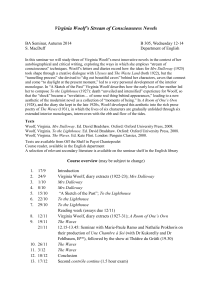
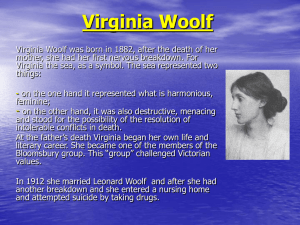
![Special Author: Woolf [DOCX 360.06KB]](http://s3.studylib.net/store/data/006596973_1-e40a8ca5d1b3c6087fa6387124828409-300x300.png)


